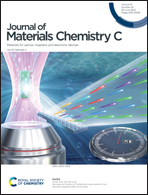Supramolecular Fe II4L4 cage for fast ammonia sensing†
Abstract
The design and construction of colorimetric ammonia (NH3) sensors with high selectivity, great stability and short response times at room temperature are highly needed for human health and food safety. We report herein a chiral supramolecular FeII4L4 metal-organic cage (MOC-1) able to detect NH3(g) at room temperature in less than 10 s, which we used to monitor food safety at 4 °C on fresh bacon bits. The detection is accompanied by a dramatic colour change from light brown to purple. In addition, MOC-1 exhibits superior selectivity among NH3(g) and twelve analytes including common solvents and amines. The reproducibility was studied by five continuous cyclic tests. Simple and low-cost smartphone-based and chemometrics analytical methods were used to study the sensing performance. The thermal stability is more than 200 °C. The sensing mechanism is associated with a high-spin to low-spin transition of the FeII ions, as expected for a ligand field strength that meets spin crossover conditions. These results show the high potential of MOC-1 as a convenient and inexpensive NH3 gas sensor at room temperature, which could be used in the field of food safety assessment.



 Please wait while we load your content...
Please wait while we load your content...